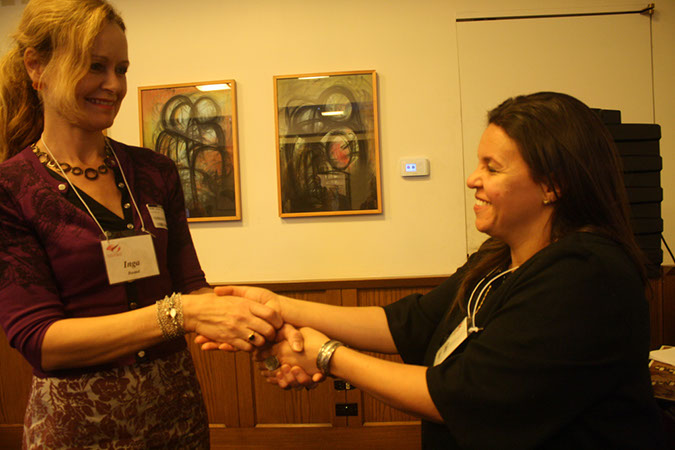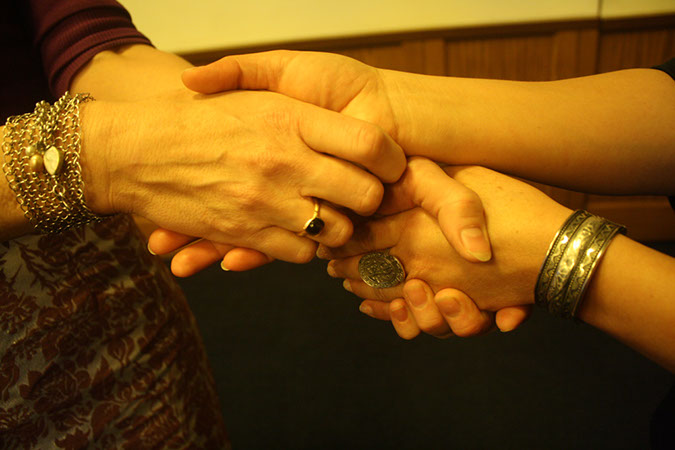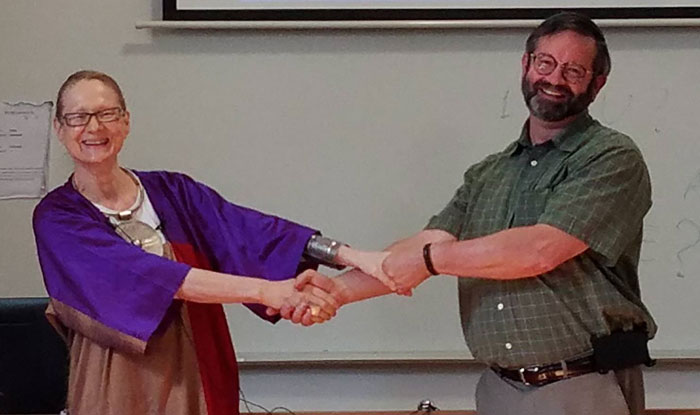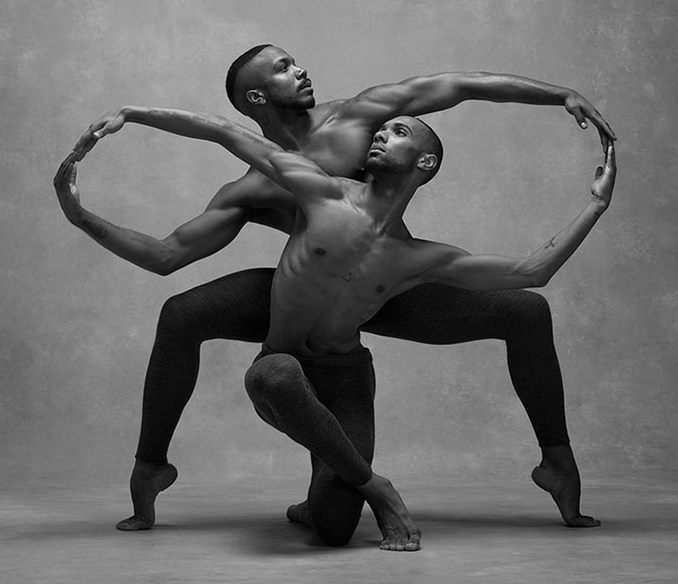Home | Who we are | Evelin G. Lindner | Summary of Humiliation Theory by Lindner (Narrative)
Reflections on Humiliation and Dignity
by Evelin
Lindner, in continuous dialogue with Linda Hartling and other HumanDHS membersShort summary, as narrative, without references, 2004/2013, always developing further since
See also a very short summary, 2007, and a longer text, 2004/2013
Adapted from (slightly revised in 2013):
Lindner, Evelin G. (2004). Humiliation in a Globalizing World: Does Humiliation Become the Most Disruptive Force?New York, NY: Paper prepared for the "Workshop on Humiliation and Violent Conflict," November 18-19, 2004, at Columbia University.
![]()
Please ask the author for permission when you wish to quote her.
Keywords: circumscription, new technologies of communication and mobility, new visions of the world, ingathering of humankind (globalization, global village), shift to a more relational global life world, weakening of Security Dilemma, shift from fear to humiliation, Human Rights ideals, in-group ethics, continuous liberation of underlings (egalization), ranked worthiness of human beings, equal dignity for all, phenomenon and dynamics of humiliation (expressed in acts, feelings and institutions), honor-humiliation, dignity-humiliation, unequal human worthiness, humility of equal dignity, depression and apathy, genocide, terrorism, constructive social change (Mandela), new public policy, new decent institutions, attention to maintaining relationships of equal dignity, new social skills for maintaining relations of equal dignity and healing and preventing dynamics of humiliation, new leaders, paradigm of policing, social control, male and female role descriptions, liberation efforts, third parties, resolution and transformation of necessary conflict, celebrate humanity, unparalleled window of opportunity, dignism
To understand a globalizing world, we need research with a global outreach, as well as the participation of researchers who have a global outlook and possess experiences that enable them to see the world from different angles. In my case, a specific biography caused me to acquire a profoundly global perspective and identity. This experiential background has led me to conceptualize psychology in specific ways, first, as being embedded within broader historic and philosophical contexts, second, as being profoundly intertwined with global changes, and third, as currently gaining significance. I avoid single interest scholarship, work trans- inter-, and cross-, and multi-disciplinary, and probe how even local micro-changes may be embedded within larger global changes (see my books, Making Enemies: Humiliation and International Conflict, 2006, Emotion and Conflict, 2009, Gender, Humiliation, and Global Security, 2010, and A Dignity Economy, 2012).
I begin by giving attention to new technologies of communication and mobility (such as the internet, or transportation by airplanes, for example), that allow for a) new visions of the world, b) the ingathering of humankind (ingathering is an anthropological term for the coming-together of tribes, see, for instance, Ury, 1999) and c) for continuous liberation uprisings of those at the bottom.
To summarize William Ury (1999), the first 95 percent of humankind's history went by relatively peacefully, with small bands of migratory foragers cooperating within noticeably egalitarian societal structures. The available abundance of wild food provided foragers with an expandable pie of resources and a win-win frame. Roughly 12,000 year ago, a win-lose logic became salient, agriculturalism evolved, and hierarchical societies began to be pitted against each other in war. Circumscription theory is thus very important in this context, see Carneiro (2012). (This is not to be confused with a "noble savage" approach; humans are social creatures and capable of doing what is called "evil" and "good." Furthermore, present-day foragers cannot be used as direct window into the time prior to 12,000 years ago.)
Today, new technologies give humankind access to profoundly new visions of the world. Planet Earth has finally become visible as what it always was, a tiny planet in a vast universe, and home to all humankind. Television news programs around the world nowadays begin with the image of a turning globe, a view that no human being in the past had access to.
Technological innovations also enable people to relate to each other in profoundly new ways. People from around the world now communicate directly with each other and meet as never before. The new technologies drive the
ingathering of humankind. In contrast to its many destructive aspects, this phenomenon is a promising aspect of globalization. It is the coming-into-being of one single global village, of one single in-group of humanity. "For the first time since the origin of our species, humanity is in touch with itself" (Ury, 1999, p. xvii). Homo sapiens is about to create a global knowledge society, explains Ury, thus returning to the win-win frame of early migrating foragers, and opening the chance to regain earlier relatively peaceful egalitarian societal structures for the global "tribe" of humankind.
The term global village signifies that at the global level one single family of humankind is presently emerging and that the notion of "out-groups" disappears. As long as the separateness of communities characterized the global theatre, the security dilemma was strong. It left no other option than to live in continuous fear of unexpected attacks from outsiders. The ingathering of humankind turns formerly separate communities into one single community in which relationships play a more prominent role than before. No longer can separate communities maintain separate "interests" in isolation The quality of their relationships with others gains significance. The decisive element for potential conflict moves from separate interests to the quality of relationships. In an atmosphere of mutual respect, conflicting interests can now be accommodated. In an atmosphere characterized by dynamics of humiliation, however, conflicting interests risk fuelling violence.
The coming-into-being of one single in-group is new; it brings people into mutual relationships. No longer do they belong to separate communities that appear mutually opaque and incomprehensible to each other. In other words, the security dilemma weakens. Relationships, however, have many potential outcomes. They can range from friendship to feelings of humiliation when respect and recognition are deemed lacking. In the wake of the weakening of the security dilemma, the formerly dominant emotion, namely, fear of the unknown outsider, is increasingly replaced by the desire to be recognized and appreciated by one's fellow human beings. This leads to feelings of humiliation when respect, recognition, and appreciation are perceived to be wanting. Thus, we can observe a shift toward a more relational global life world, a weakening of the security dilemma, and a shift from fear toward humiliation as emotional driving forces (including fear of humiliation).
Ironically, one might add, many of the technological means for this trend toward connection emerged in the opposite context, namely, in a context of disconnection and warfare. Classical warfare, however, turns inappropriate when the security dilemma weakens in the global village. Now, these technological innovations give the have-nots the tools to connect and form uprisings and liberation movements. For the first time in history, the maintenance of continuous liberation moves is feasible. Both features, the new vision of the world, and the new means for coming together, and thus for continuous liberation efforts of those at the bottom, represent new phenomena and make "lessons from history" obsolete in many ways. Profoundly new ways of thinking must be developed.
Intertwined with the ingathering of humankind is the rise of human rights ideals. Human rights ideals entail two historically new aspects. First, they may be labeled in-group ethics, which now are globalized, while out-group ethics lose their scope. Second, they drive the historically first continuous liberation movements and uprisings of underlings (Lindner has coined the term egalization for this revolution, matching the term globalization; globalization describes the trend towards the horizontal coming-together of humankind, while egalization describes the vertical coming-together of humankind, on one single level of equal dignity for all).
As to the first aspect, human rights ideals in many ways resemble the ethical norms that people usually apply within what they regard their in-group. In resonance with the ingathering of humankind, in-group ethics embrace the entire world, and out-group ethics lose ground. As to the second element, human rights ideals entail a revolution: their advocates drive a transition that moves away from societies where ranked worthiness of human beings (higher beings presiding over lesser beings) is regarded as normal, to the notion of equal dignity for all. Equal dignity for all is a revolutionary norm. It turns strategies that formerly were regarded as appropriate into violations (see the significance of the year 1757 for this historical transition). These violations then carry the potential to elicit feelings of humiliation. For example, security and peace can no longer be attained by parading "strength" and holding down people by sheer force. While this might have rendered humble underlings in former times, it no longer does now.
In the new historical context, the phenomenon of humiliation (expressed in acts, feelings and institutions), gains significance in two contexts, a) in the context of the new, more relational reality of the world, and b) in the context of emerging human rights ideals. Dynamics of humiliation profoundly change in resonance with the larger historical transition from a world steeped in honor codes of unequal human worthiness to a world of human rights ideals of equal dignity. Dynamics of humiliation move from honor-humiliation to dignity-humiliation, and they gain more significance.
As soon as human rights ideals have entered the hearts and minds of people, and these people move closer together, the notion of humiliation changes profoundly as compared to contexts prior to human rights ideals having become significant, and it gains significance. Formerly, it was seen as the duty of inferiors to accept being put down. They had no right to invoke feelings of humiliation. Only masters were permitted to label their privileged position as "honorable" and defend their honor, for instance by way of duels. Superiors were expected to become angry through humiliation, inferiors were expected to become humble. In human rights contexts the situation is turned on its head. Inferiors are now lifted up, which means that they are permitted to use words such as oppression or humiliation to label their lowly state, while masters are told that they ought to descend from arrogating superiority and embrace the proud humility of equal dignity, in mutually respectful alliance with the now entrusted underlings.
 Arrogation ArrogationProud humility Humiliation |
The human rights movement aims at collapsing the master-slave gradient of arrogation/humiliation to a middle line of proud humility in equal dignity (see graphics). The practice of masters arrogating superiority and subjugating underlings is now regarded as illegitimate and obscene, and human rights advocates invite both, masters and underlings, to join in shared humility at the level of equal dignity. It is important to note that the horizontal line in the graphic is meant to represent the line of equal dignity and humility. This line does not signify that all human beings are equal, or should be equal, or ever were or will be equal, or identical, or all the same. Equal dignity is not the same as identical sameness, and, while equal dignity has links with equality, these links are complex.
Brigid Donelan kindly commented this model as follows (personal message, December 20, 2004), "This is a model with twin features: one a historical trend and the other a contemporary potential/choice. We may think of humanity evolving through stages of pride, honor and dignity. We can also see that each stage is 'alive and well' within each contemporary individual, as a choice/potential. The value of the model lies in clarifying the choice, and suggesting a trend towards emergence of a 'global knowledge society,' for which there is certainly evidence, and benefits for all."
Feelings of humiliation may lead to various consequences, among them, a) apathy and depression; b) the urge to retaliate with inflicting humiliation on humiliators, be they real or imagined (see humiliation entrepreneurs who unleash genocide and terrorism), or c) feelings of humiliation may also lead to constructive social change (see Paolo Freire, Clodomir de Morais, Mahatma Gandhi, and Nelson Mandela).
What is the call of the day? New public policies for driving globegalization must be developed, so as to create a decent world (see The Decent Society by Avishai Margalit, 1996). These policies need to entail three elements that are intertwined. First, new decent institutions have to be built, both locally and globally, institutional structures that contribute to healing and preventing dynamics of humiliation; this can be realized by way of subsidiarity, so that unity in diversity can flourish (instead of uniformity without diversity and division without unity) and dignism can become reality (rather than other, outdated oppressive and predatory -isms). This can be brought about by multi-pronged efforts of all committed world citizens (see Margaret Mead's adage) co-creating global and local systemic imperatives (Ellen Meiksins Wood) that have the common good of humanity at heart. Second, new attention has to be given to creating a global culture where relationships of equal dignity can flourish in a unity-in-diversity fashion, where bio- and cultural diversity is celebrated. Third, new social skills have to be learned, to maintain relations of solidarity in equal dignity.
We need a new type of leaders, Mandelas so to speak, who are no longer autocratic dominators and humiliation entrepreneurs who lead into hateful polarization, but knowledgeable co-facilitators and wise co-motivators who co-lead toward the respectful and dignified inclusion of all of humankind on a vulnerable planet.
All three tasks, albeit informed by ideas and practices developed in the past, are historically new and unparalleled in their scope. The aim is a future global society that unites in care for each other and our shared habitat. It is a global society, where equal dignity for all is respected and acts and structures of humiliation dismantled and dynamics of humiliation healed and prevented.
With respect to violent conflict, both at the global and local level, the paradigm of good quality policing of neighborhoods needs to replace the paradigm of war on enemies. The global village, as any village, needs to maintain its inner security by good quality policing that heeds the dignity of all involved. War is typically waged with neighboring "villages." In the case of the global village, there is no "neighboring village" left. Thus the paradigm of war loses its anchoring in reality, and the paradigm of policing is what is left. And good quality policing selects the best from traditional skills of containment and infuses them into new forms of dignified respect.
During Lindner's time in Egypt (1984-1991), she was amazed by the low rate of crime and unrest in Cairo, a huge metropolis of at that time ten to 15 million people. She soon understood that a high amount of social control was part of Egyptian culture. She frequently witnessed incidents that gave testimony to this social control. When she analyzed conflict resolution and containment scenes in the streets of Cairo, she observed a twenty-to-two ratio, or at least a ten-to-two ratio. Ten or up to twenty physically powerful men were required to cool and pacify two clashing opponents. The young men in the Cairo scenes did not need to exert brute force because they outnumbered the quarrelers. Their overpowering count enabled them to combine containment and respect. Respect alone would not have sufficed, and containment through outnumbering alone neither.
If this scenario is to be taken as a blueprint for attending to violent conflict, it is a combination of containment and respect that has to be striven for by the global community, the United Nations, and bystanders in general. Resources for the prevention, containment, and resolution of conflicts around the world are to be increased. Overpowering numbers of blue helmets/global policepersons with credible containment mandates and well-devised containment strategies are required, yet, only if embedded in an overall approach of respect.
This approach, incidentally, combines elements of containment and respect that also can be mapped onto traditional male and female role descriptions (see Lindner, Gender, Humiliation, and Global Security, 2010). What is combined is the "female" script of talking, understanding, empathy, perspective-taking, and healing on one side, and the "male" social template for overpowering, coercion, containment, and force on the other. "Male" strength and well-dosed containment are required to hold clashing opponents. "Female" awareness of the cohesion of the social fabric is needed to take the
quarrelers
seriously. To combine the "male" aspect of force with "female" empathy could be described as the modern recipe of conflict resolution.
UNESCO's Culture of Peace Programme can serve as an example. It urges the strengthening of the "female" aspect in conflict resolution efforts. The list is a long one: using multi-track, "track II" and citizen-based diplomacy; installing early warning institutions; rethinking the notion of state sovereignty; setting up projects to better study and understand the history of potential conflict areas, collect this information and make it available to decision makers; using psychology not only on a micro level, but also on a macro level, taking identity as a bridge; keeping communication going with warring parties; talking behind the scenes; including more than just the warlords in peace negotiations; developing conflict-resolution teams with less hierarchy and more creativity; setting up mediation teams; installing "truth commissions;" allowing warring parties to feel the world community's care, respect and concern; taking opponents in a conflict out of their usual environment; taking the adversaries' personal feelings and emotions seriously; recognizing the importance of human dignity; introducing sustainable long-term approaches on the social and ecological level; progressing from spending aid-money after a disaster to allocating resources to prevent it; and so on.
Thus, globalization opens space for "female" strategies, inviting both women and men into embracing and combining them with the traditional "male" strategies of containment. Human rights ideals call for egalization, meaning equal dignity for all humankind, to be the broader guiding framework for globalization.
For the downtrodden around the world, be it women or discriminated minorities of any kind, who wish to promote successful and constructive processes of liberation to change their lowly lot, a Nelson Mandela would offer yet another threefold advice. He himself implemented this strategy most wisely: First, people who wish to change their lowly situation constructively, have to psychologically step outside of the master-slave dyad and learn to think autonomously. Second, they have to stop merely re-acting to the master's actions and definitions, and begin to act. Third, people wanting to rise up from lowliness must persuade those who hold on to master elite positions that change is necessary and unavoidable, both normatively and practically, and that a peaceful transition is preferable to violence and war. With its notion of victory over enemies, war only turns a unifying world back into a fragmented world.
For third parties who are trying to secure peace around the world, yet another threefold approach seems helpful. First, it is important to identify the fault lines between what may be called moderates and extremists in opposing camps. To give an example, not the Hutus or Tutsis are the parties to reckon with, but the Mandelas (they could be called the moderates) as opposed to the humiliation entrepreneurs (here called extremists) on both sides. Second, third parties need to facilitate alliances between the moderates of all camps with the aim to transform extremists' violent responses to feelings of humiliation. Third, humiliating living conditions of the broad masses must be minimized, because otherwise frustrated masses will be vulnerable to recruitment by humiliation entrepreneurs.
Sultan Somjee, Kenyan ethnographer honored by the UN for his efforts to preserve indigenous people's peace traditions, said in response to the Iraqi Prisoner Abuse of 2004, "Humiliation does not have nationality, religion, color or gender. Humiliation of one human being humiliates humanity and our dignity of being." One could add, only if we avoid institutions, attitudes, and behaviors that have humiliating effects will we create a future for our world in the spirit of Kofi Annan's promotion for the Olympic Games of 2004, namely "celebrate humanity."
At the present historical juncture, to my observation, the most pressing problem is the avoidance of necessary conflict by those who are in a position to address it. Those with resources, many of the wealthy of this world, rather than standing up, choose to stand by (Staub, 1989), while fellow humans and the planet are being exploited. They are the new Rajas so to speak, similar to the Rajas under British rule who continued enjoying privileges while being complicit in colonization. Their duty would be to invest their privileges into constructive change in the spirit of Paolo Freire, Clodomir de Morais, Mahatma Gandhi, and Nelson Mandela.
As to the exploitation of social resources, on the International Day for the Abolition of Slavery (2nd December) in 2012, 21 million women, men, and children were trapped in slavery all over the world, forced to work, held through fraud, under threat of violence, for no pay beyond subsistence. Today’s slavery focuses on big profits and cheap lives. It is not about owning people like before, but about using them as completely disposable tools for making money. Contemporary forms of slavery: debt bondage, serfdom and forced labour, trafficking of persons and trafficking for the purpose of organ removal; sexual exploitation, child labour, forced recruitment of children for use in armed conflict, forced marriage, the sale of wives, or widow inheritance (www.ilo.org).
As to the exploitation of ecological resources, to keep up present growth rates, several planets would be needed.
The title of the latest report to the Club of Rome is The Plundered Planet. The author posits that the present massive exploitation of the final natural resources of the planet is a sad symbol of desperation and a dead-end: "…it is an impotent attempt to keep going at all costs, even though you know exactly: it's a dead end."
At present, what needs to rise to our attention is not just open war between or within nations, it is the sophisticated covert war on the social wealth of all societies and the ecological wealth of our planet. Indignez vous! Cry Out! is the voice of Stéphane Frédéric Hessel in 2010, a French wartime resistance hero who was born in 1917. He cried out against Nazism in the 1940s and calls on people today to "cry out against the complicity between politicians and economic and financial powers" and to "defend our democratic rights. (See also A Dignity Economy, by Evelin Lindner, 2012). What is needed is to cease waging unnecessary conflicts, and stop avoiding important conflicts.
Lynn King wrote from China to our network on 26 December 2013: "I would include the humiliation of poor farmers around the world as part of the 'violent conflict' that is destroying the world now. Suicide rates of farmers in India, Australia, and China not to mention many other places is occurring annually in epic numbers as climate change and economic and social oppression gives them no way to survive while they are actually performing a critical role in society."
An unparalleled window of opportunity opens up at the present historical juncture. The image of our Blue Planet from the astronaut’s perspective epitomizes this window. The Blue Planet image provides a powerful frame for global cooperation. None of our forefathers was able to see anything comparable. None of our predecessors was able to fathom in the same way as we can today that we, humankind, are one single family living on one tiny planet. None of the founders of religions, philosophies, or empires had access to the vast knowledge as we possess today about the universe and our place in it. This is a historic opportunity. We are given space to transcend the misconception that eternal exploitation and domination is feasible. We can leave behind our misguided conviction that squeezing social and ecological resources is the only way. There is no need to artificially keep alive the security dilemma. New Realpolitik means acting when history offers a chance.
"Those who are late will be punished by life itself," is a sentence associated with Mikhail Gorbachev and his speech on October 7, 1989. He spoke to East German leaders who failed to see the signs of the times. Also we, humankind, need to see the signs of the times.
When circumstances are new, many ideologies are now dead-end ideologies, also those that once were perceived as salvation. Clinging to them will not do. Only a down-to-earth intentionally driven continuously evolving process of co-creation toward dignity will do, co-creating a future of mutual care in equal dignity for all people and our planet. Only a global consciousness of unity in diversity can realize the promise of Morton Deutsch's crude law of social relations, which stipulates that "cooperation breeds cooperation" (Deutsch, 1973, p. 367). In a compartmentalized world, cooperation merely serves competition for domination. Everybody is called on to join in. Optimism and pessimism are irrelevant when the house is on fire and there is still a chance for rescue. Our principal duty, at present, is to invest all we have into the change that Nelson Mandela envisioned, dignified and dignifying change.
Dignity-ism, or dignism, means a world where every newborn finds space and is nurtured to unfold their highest and best, embedded in a social context of loving appreciation and connection. A world, where the carrying capacity of the planet guides the ways in which everybody's basic needs are met, a world, where we are united in respecting human dignity and celebrating diversity, where we prevent unity from being perverted into oppressive uniformity, and keep diversity from sliding into hostile division.
Reflections from December 10, 2013, and October 29, 2016:



From Evelin's global point of view, unity in diversity is helpful as a motto to describe how the unity of communal solidarity, or what Evelin calls "big love" in her Gender book, can replace isolated or even hostile division, and how diversity in the context of equal dignity needs to replace oppressive uniformity. Evelin uses the infinity symbol, or the Möbius Strip, or the lying 8, ∞, to make this motto visible, and to show how it can model the form of dialogue that truly manifests the human rights ideal of "every human being is equal in dignity." Throughout her global life journey, Evelin found two cultural realms where each of these cultural traditions can be experienced at their best: In the photos above, Inga Bostad stands for the Norwegian cultural heritage of equality in dignity or likeverd that opens space for diversity, while Doaa Rashed stands for the cultural heritage of collective cohesion in the Nile Delta, a social cohesion that is indispensable when bridges are needed to be constructed to bring unity into diversity (Evelin lived in Cairo from 1984-1991). The photos were taken at the 22nd Annual Dignity Conference, or 2013 NY Workshop.


The photo above to the left was taken in September 26, 2016, and shows Glyn Rimmington together with Evelin demonstrating the infinity symbol as a symbol for dialogue. Mara Alagic, who took this photo, was later inspired to contribute with the picture you see on the right side, which shows the infinity symbol in unprecedented beauty. Thank you, dear Mara! She found this wonderful “infinity dance” on the website of the Alvin Ailey Dance Theater in Manhattan.
The photo with Glyn Rimmington was taken at the 5th Biennial Meeting of the Knowledge Federation, titled 'Tools and Practices for the Collective Mind Revolution', a conference that was held at the Inter-University Centre Dubrovnik, 25th September–1st October, 2016.
See the video of Evelin Lindner's talk titled 'From Systemic Humiliation to Systemic Dignity' (also the Powerpoint presentation).